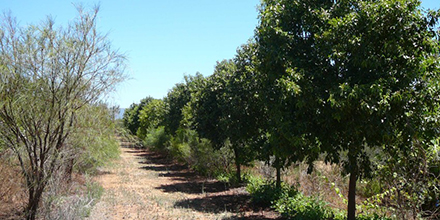During the 1990s and early 2000s, the Forest Products Commission (FPC), then Department of Conservation and Land Management, helped develop methods to grow high-value tropical sandalwood plantations near Kununurra, Western Australia. Source: Forest Products Commission
Following the encouraging results in Kununurra, the FPC expanded the work to investigate whether tropical sandalwood could also be grown further south in Carnarvon.
Between 2006 and 2008, the FPC established 7.3 ha of irrigated sandalwood plantations at the Gascoyne Research Facility, Department of Primary Industries and Regional Development (DPIRD), Carnarvon.
In Carnarvon, the FPC tested two tropical sandalwood species (Santalum album and Santalum austrocaledonicum) for their potential to produce high value aromatic wood within irrigated plantations.
Both sandalwood species proved to be successful, growing relatively quickly and producing good quality oil after 16 years.
In 2022, the 7.3 ha sandalwood plot (aged 14-16 years) produced a total of 21.5 tonnes of commercial wood, with good quality oil and heartwood within the logs.
With sandalwood being a root hemi-parasite, one of the other main aims of the trials was to compare the effects of different host species on sandalwood growth in this region.
A range of host species were found to be suitable, but a wattle species named Acacia coriacea subsp. pendens appeared to be the best host.
This host species grew well under relatively low watering regimes, had good tree shape with minimal pruning requirements, and provided good sandalwood growth rates.
One of the limiting factors for growing tropical sandalwood in the Carnarvon region appears to be the availability and cost of good quality irrigation water.
The trials were set up using relatively good quality water with a salinity of only 330 ppm.
However, the trees may not perform as well if the plantations are irrigated with more saline water.
Information from these trials would be useful for tropical sandalwood growers in northern Australia, the sandalwood industry, and groups in the Gascoyne region who have the ability and interest to irrigate sandalwood trees with good quality water.
For the full report, please visit https://www.wa.gov.au/government/publications/fpc-tropical-sandalwood-trials-carnarvon-report






